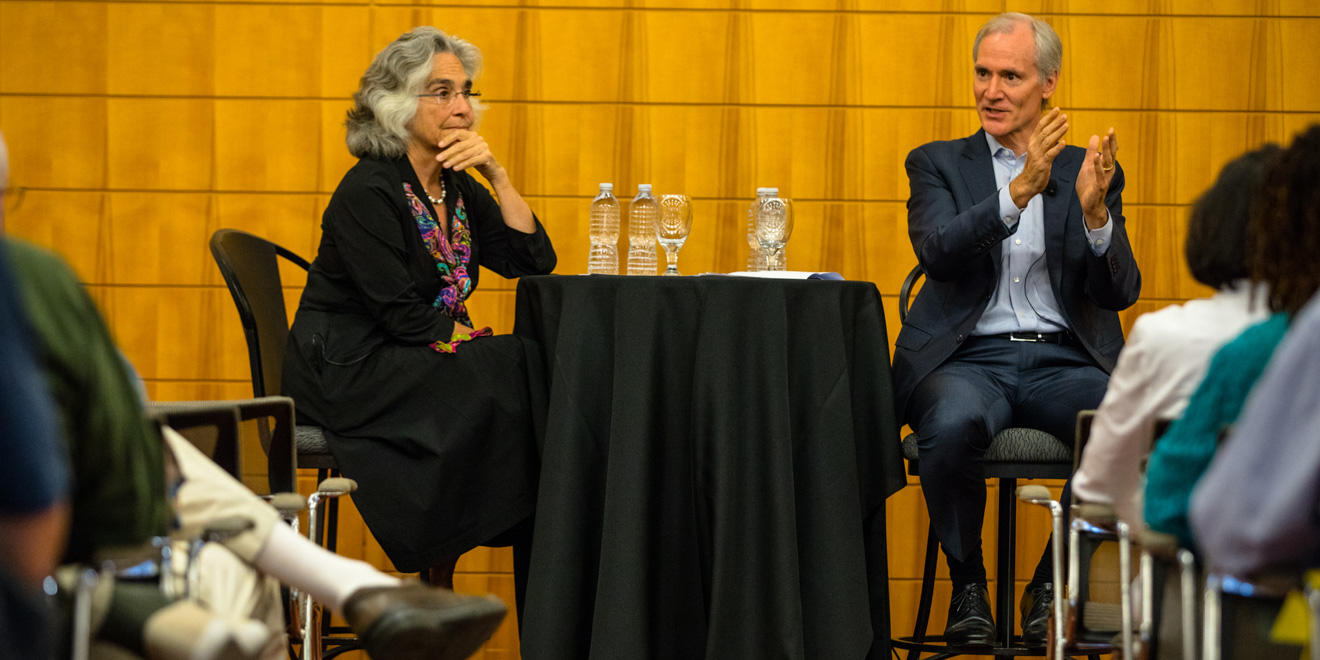Long-term planning, freedom of speech, research funding and sexual assault were prominent topics during a wide-ranging “town hall” discussion hosted by University President Marc Tessier-Lavigne and Provost Persis Drell on Wednesday as part of their efforts to increase their communication with the Stanford community. The session was open to all community members but drew mostly faculty and staff.
Improving the administration’s communication — an aspect of the University that some students have criticized, particularly in the wake of controversial University decisions such as a ban on hard alcohol and a quickly-reversed decision to suspend the Stanford Band — has been one of Tessier-Lavigne and Drell’s focuses since they assumed their roles during the last school year. In addition to the town hall series, they started holding office hours and most recently began a joint blog dubbed “Notes from the Quad.”
Before diving into a Q&A session that made up the majority of the event, Tessier-Lavigne and Drell discussed Stanford’s ongoing long-range planning process, launched last year to help formulate a vision for Stanford’s future. An open call for ideas received 2,800 submissions, which four committees focused on different areas of the University are currently sifting through and synthesizing into what Drell called “white paper” summaries to be shared with the public.
“It’s not 2,800 independent ideas; there are big themes emerging and those big themes are really important,” Drell said.
“We’re making this process up as we go along,” she added later, saying that each committee is approaching its tasks differently. “But I think actually the process itself is having a really good impact on the community.”
The “white papers” will be released during winter quarter, after Stanford’s executive leadership reviews them and discusses them with the four groups. The summaries will focus on major commonalities culled from submissions, although Drell emphasized that the University will still follow up on many particular ideas it wants to pursue. Meanwhile, she said, the administration is trying to “lay groundwork” for action on issues it knows will emerge as priorities, such as affordable housing for faculty, staff and students in the Bay Area.
During the Q&A, Drell and Tessier-Lavigne fielded several questions related to promoting freedom of expression, grappling with speech people find hurtful and improving dialogue on campus. Drell briefly mentioned UC Berkeley, where right-wing speakers have stirred heated controversy and protests, and emphasized Stanford’s commitment to allowing expression of “the broadest range of ideas.”
“There is no question that free expression of ideas leads to the expression of opinions and thoughts that are threatening to some members of our communities, particularly members of marginalized communities,” Drell said. “I struggle with this personally … I deeply empathize with those … who feel physically threatened by some of the discourse, and yet I don’t know how to prevent that without then violating something else that is core to our institution.”
Giving an example of the value she’s found in open discourse, Drell, a former physics professor, recalled being challenged once to explain what diversity brought to a physics classroom.
“Forcing myself to answer that question did more to help me understand and have the ability to articulate the importance of diversity than almost any other single interaction,” she said. “I would love to help our community go through that process more.”
Tessier-Lavigne reiterated an explanation he gave at another town hall in February, describing how the University chooses when to express its opinion on political issues. Stanford avoids weighing in on policy as much as possible to avoid “silencing voices on campus,” he said, but will take stances on issues that threaten community members or the University’s core values — such as the Trump administration’s decision to end DACA — and those that directly affect Stanford’s ability to carry out its work, such as federal funding for research.
Despite worries since President Donald Trump’s election that the White House would slash such funding, Stanford has actually found strong bipartisan support in both houses of Congress for its agenda, Tessier-Lavigne said. He reported visiting Washington, D.C. four times in the last five months to lobby for University priorities.
The White House pushed earlier this year for massive cuts to research funding, including a 20 percent cut to the budget of the National Institutes of Health (NIH). But Congress ended up approving a $1 billion increase in funds for the NIH.
“The administration’s plan is being ignored by Congress,” Tessier-Lavigne said. “We’re very pleased.”
Responding to a question about Stanford’s plans to increase the diversity of its faculty, Drell wondered aloud if Stanford could learn from the recruitment techniques of its athletics coaches. She suggested a focus on younger but promising scholars.
“What if you take some of those recruitment strategies and apply them not just to the senior, superstar faculty but to the junior faculty … or follow them as postdocs,” she said. “I do believe there is more we can be doing.”
Drell also addressed sexual assault, a topic that many schools have faced scrutiny over and that has been in the news recently as Education Secretary Betsy DeVos moves to overhaul federal guidelines on how campuses handle Title IX cases. In a statement last month, Drell said that Stanford is not changing its policies in response to DeVos’ actions.
“We are not doing what we do because the federal government tells us to,” the provost said at Wednesday’s town hall. “We intend to the right thing as best we can and be compliant with state and federal laws.”
Contact Hannah Knowles at hknowles ‘at’ stanford.edu.
